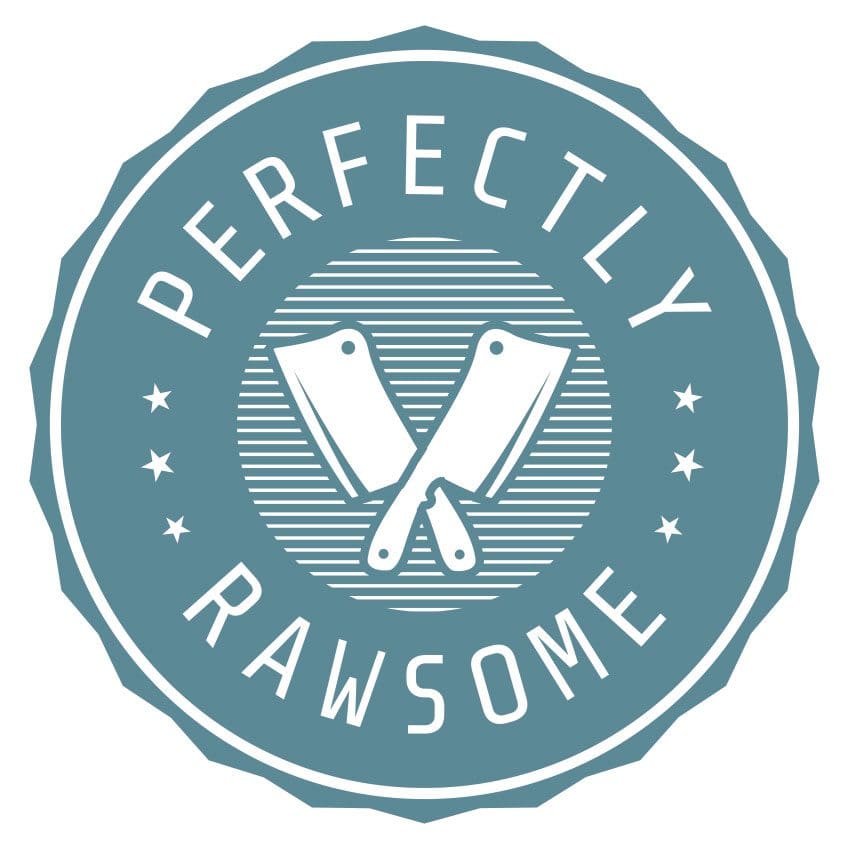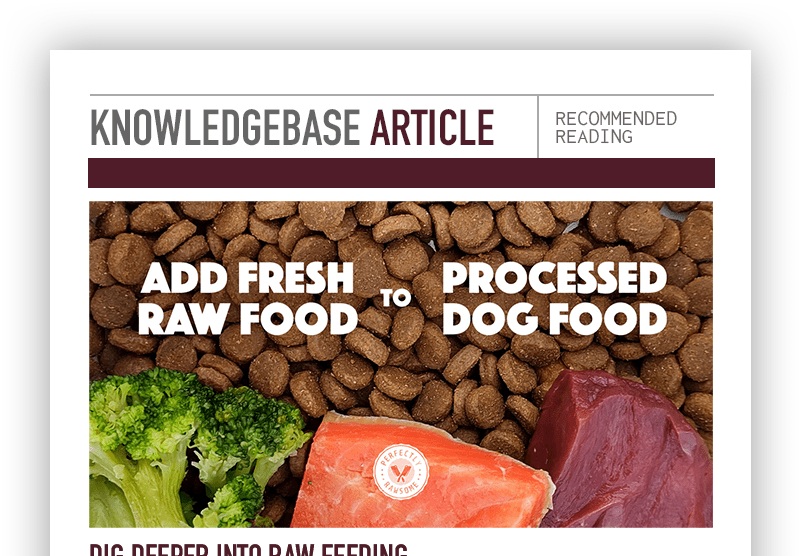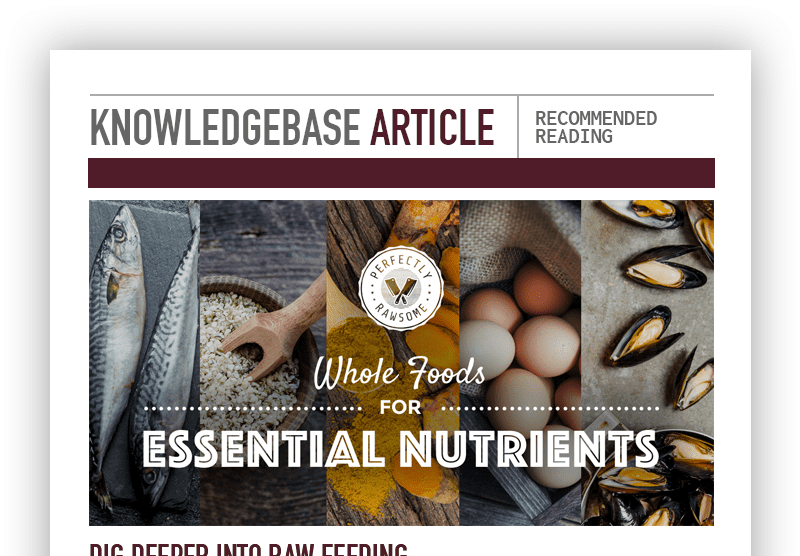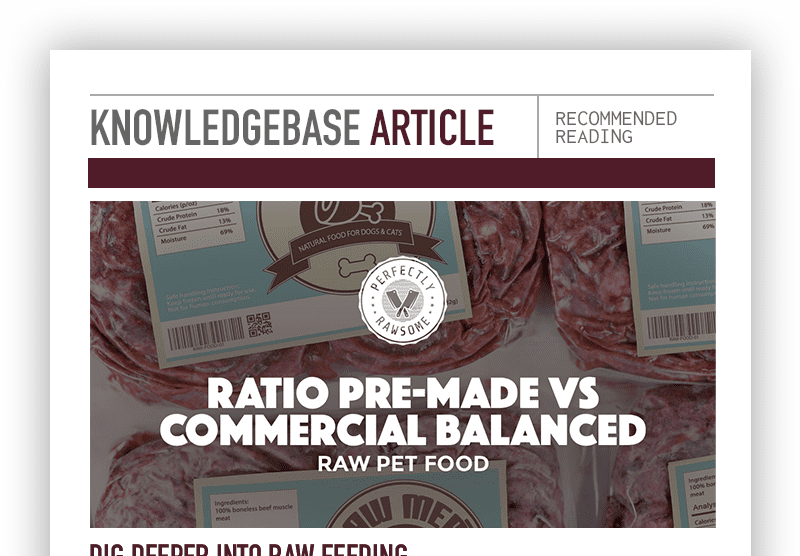Puppies and kittens require a diet that provides all essential nutrients on a daily basis to support optimal development of the musculoskeletal system, muscles, and vital organs. Therefore, the slow transition articles for adult dogs and cats are not appropriate for puppies and kittens because they are not nutritionally balanced. A different approach is necessary when slowly transitioning puppies and kittens to a fresh food diet.
Most puppies and kittens take to raw effortlessly and a slow transition is not necessary. It is recommended to switch puppies and kittens to a nutritionally balanced fresh food diet immediately. However, jumping straight into raw feeding is not always feasible for growing pets who are susceptible to digestive upset during sudden diet changes.
The switch from processed food to a fresh food diet does not need to happen overnight and the transition can be gradual. However, a slow transition for puppies and kittens must be accomplished differently than with adult dogs and cats.
Introduce Fresh Food
Fresh foods can be introduced to growing puppies and kittens in small amounts before beginning the slow transition process.
Balanced Raw Food Options
The easiest way to slowly transition puppies and kittens while maintaining nutritional balance is to use a balanced premade raw food. Although, it is possible to prepare balanced raw food at home.
Calculate Daily Calorie Requirements
Before beginning the transition to raw food it is important to calculate the pet’s daily calorie requirements.
Slow Transition Steps
There is a four step process to slowly transition puppies and kittens onto a raw diet.
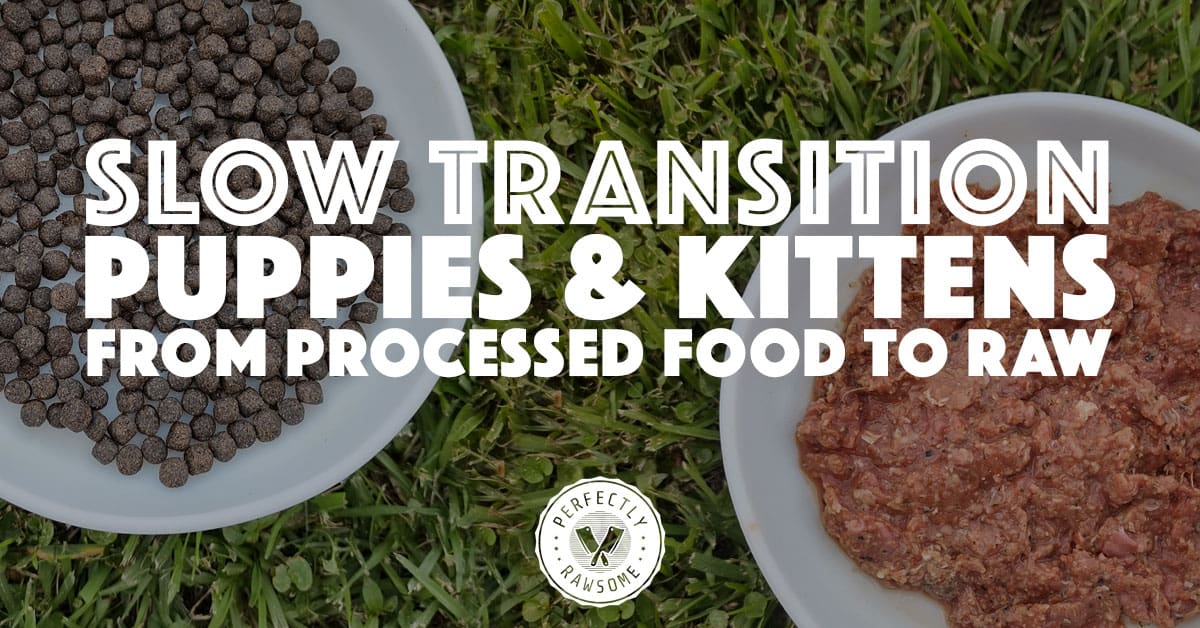
Introduce Fresh Food
It is recommended to feed the current commercial pet food for the first week after bringing home a new puppy or kitten. Removal from the mother and littermates in addition to environmental changes are stressful which can cause stress induced diarrhea. Therefore, it is recommended to avoid changing a new puppy or kitten’s diet when they are new to the household. This helps to avoid loose stools caused by the combination of stress and a diet change. The slow transition to raw food can begin once the new pet is more settled.
However, small amounts of fresh foods can be introduced to puppies and kittens before beginning the slow transition process and without balancing the fresh food additions. The addition of lean raw protein to commercial dry pet foods have been shown to improve the amino acids within the diet. The guidelines on how to introduce fresh food to adult dogs can be followed when introducing fresh food to growing puppies and kittens.
Pet parents can take a more strategic approach when introducing fresh food into their puppy or kitten’s diet to prepare them for the slow transition to a balanced raw diet. More focus should be applied towards introducing lean protein and secreting organs above other ingredients:
Lean Red Meat Protein
Out of all the protein choices lean red meats are ideal when adding raw meat to processed puppy or kitten food. Growing puppies and kittens have higher requirements than adult animals for multiple essential nutrients. Minerals such as iron and zinc will be higher in lean red meats than in white meats.
Liver, Ruminant
All liver is notable for its Vitamin A content. However, liver from ruminant animals also provides essential copper. Therefore, ruminant liver is more nutrient dense than poultry or pork liver. Ruminant animals include beef, lamb, venison, bison, goat, and elk. Liver from these sources is the recommended liver choice in homemade fresh diets for puppies and kittens.
Spleen
Both puppies and kittens have a high requirement for essential iron. The only whole food that provides enough iron to meet nutrient guidelines for puppies and kittens is spleen. Spleen is most accessible from beef, pork or lamb. It is the recommended secreting organ in homemade fresh diets for puppies and kittens.
Add Fresh Raw Food to Processed Dry Dog Food
The addition of other fresh ingredients are safe to feed – these ingredients include raw meaty bones and seafood. They are generally well-tolerated and do not cause any gastrointestinal complications when transitioning to a fresh food diet.
Unbalanced fresh food additions should not exceed 20% of the daily intake to avoid nutritional deficiencies. Once fresh food exceeds 20% of a puppy’s and kitten’s diet it must be nutritionally balanced on a daily basis.
Balanced Raw Food Options
When pet parents prefer to slowly transition their puppy or kitten to raw food or to feed more than 20% fresh food, there are two options to consider. The easiest approach is to utilize an AAFCO or FEDIAF balanced premade raw food that is commercially available. The second option is to home prepare raw food that provides all essential nutrients for optimal development for puppies and kittens.
Commercial Balanced Premade
A commercially balanced premade raw food ensures that the raw food provides all essential nutrients. This will avoid feeding an unbalanced diet to a growing puppy or kitten when following the slow transition steps. Nutritional requirements are set by various organizations. The two primary standards include the Association of American Feed Control Officials (AAFCO) and European Pet Food Industry Federation (FEDIAF).
These are the nutritional standards that commercial pet food manufacturers must adhere to when producing “complete and balanced” pet food. There are multiple pet food companies who manufacture raw pet food to these nutritional standards. Most AAFCO and FEDIAF commercial balanced raw pet foods are formulated to All Life Stage nutritional standards. This ensures the food is compliant for the Adult Maintenance, Growth and Development, and Reproduction life stages. Therefore, these commercial raw foods are nutritionally sufficient and can be used to slowly transition puppies and kittens to a balanced raw diet..
However, not all commercially sold raw pet foods are created equal. It is important to choose a commercial raw food that is formulated to AAFCO or FEDIAF guidelines for All Life Stages with appropriate ingredients.
1. Macronutrient Analysis
An AAFCO or FEDIAF balanced pre-made food should provide the protein and fat analysis of their formula on an As Fed basis. The average puppy or kitten should be consuming a raw diet that is about 9-10% fat on an As Fed basis. Overly high fat diets should be avoided.
2. Calcium to Phosphorus Ratio
Puppies and kittens require a diet that provides a balanced calcium to phosphorus ratio for optimal bone development. The Ca:P ratio for large and giant breed puppies requires special consideration. They should be fed a diet that provides a Ca:P ratio between 1.1:1 and 1.2:1. While kittens and small breed puppies have a little more flexibility, they still require the Ca:P ratio to fall within a range of 1:1 and 1.4:1.
3. Identifiable Whole Foods or Supplements
Some pre-made raw foods will adhere to AAFCO or FEDIAF guidelines on paper. However, the plant ingredients often used to accomplish this should not be relied upon for essential nutrients. This is not to say that plant ingredients are to be avoided for puppies, but essential nutrients should be met by animal based ingredients and supplements rather than plant ingredients.
It is important to identify whether the premade uses appropriate ingredients and supplements to meet all essential nutrients for optimal development. Avoid premades that only contain meat, bones, organs and plants without any additional supplements to make up for the common deficiencies. In addition to those ingredients, a balanced premade should include certain whole foods or supplements to fulfill the seven common deficiencies. Additionally, balanced premade food for kittens should include a taurine supplement.
There are several considerations to make when choosing how to slowly transition a puppy and kitten to a raw diet. It is easier to utilize a commercial balanced pet food for All Life Stages during the slow transition even when the end goal is a Do It Yourself (DIY) raw diet. There are multiple brands available that provide balanced raw pet food formulated to AAFCO nutritional standards. The following brands produce All Life Stage balanced raw food for puppies and kittens within the USA:
Balanced Home Prepared Diet
A pet parent may choose to prepare balanced raw food at home for the transition process. However, this requires research and calculations to ensure that the recipe provides all essential nutrients that puppies and kittens require for optimal development. It is possible to prepare a balanced raw food at home with the correct knowledge and ingredients. Utilizing a balanced recipe from a qualified professional pet nutritionist is recommended if the pet parent is not confident in their ability to create a balanced raw recipe for growth and development requirements.
The slow transition process includes mixing balanced raw food with dry pet food. This makes feeding whole raw meaty bones difficult and needs to be accounted for in a home prepared diet used for the slow transition. Therefore, it is recommended to use ground bone or a bone meal supplement to ensure that the homemade raw food supplies the appropriate amount of calcium and phosphorus for optimal development at each stage of the transition.
The home prepared diet can be accomplished in two different ways – complete ground food or whole pieces with a bone meal supplement.
1. Home Prepared Ground Food
A homemade ground raw food can be accomplished by using a meat grinder with one or more horsepower to effectively grind raw meaty bones. However, meat grinders capable of grinding meaty bones are expensive.
2. Whole Pieces + Bone Meal Supplementation
The additional expense of a grinder that is capable of grinding raw meaty bones is not feasible for many pet parents. Therefore, using whole pieces of raw ingredients plus a bone meal supplement is the alternative to purchasing a grinder.
Preparing a balanced raw food at home involves more than simply following the raw diet puppy ratios. Both PMR and BARF puppy ratio guidelines can be used as a base to create a homemade raw diet. However, additional whole foods and supplements are required in order to fulfill common nutrient deficiencies within ratio diets. Whether the homemade diet provides all essential nutrients for growth and development will depend on the ingredients chosen within the ratios in addition to the recommended whole foods.
Calculate Daily Calorie Requirements
Before beginning the transition to raw it will be necessary to calculate the daily calorie requirements. The amount of calories a puppy or kitten needs depends on age and activity. Calculations on how many calories are needed to sustain optimal growth can be calculated with a few simple math formulas.
All balanced commercial pet foods provide calorie information in multiple formats. This information can be found on the product packaging or on the manufacturer’s website. It can used when calculating the calories in the current commercial diet:
1. Calories per Cup
All dry pet food will include the total amount of calories per cup on the label. However, the term “cup” is often misinterpreted among pet parents as drinking cups. In the terms of this discussion one cup is a cooking measure of volume commonly associated with cooking and serving sizes. It is traditionally equal to one-half US pint.
2. Calories per Kilogram
Dry pet food will also include the calorie amount per kilogram of food in addition to calories per cup. This is useful for pet parents who measure their pet’s food in grams versus cups.
3. Calories per Can
Moist and wet food often provide calorie information per unit. Therefore, the nutritional label will include calories per can for canned pet food.
A puppy and kitten’s current calorie intake can be calculated by using the calorie information supplied by the dry or canned food that is currently being fed.
Puppy Calorie Calculation Example
Below is the age and weight of the puppy that will be consistently used in examples throughout the article:
8-10 weeks
15 lbs (6.8 kg)
Dry Dog Food Calorie Calculations, in Cups
Below are the calculation steps when feeding dry dog food in measuring cup increments:
400 kcal per cup
The dry dog food is 400 calories per 1 level measuring cup consumed.
2 Cups Consumed
A total of 2 level measuring cups is consumed daily.
400 kcal x 2 cups = 800 kcal
A total of 800 calories is needed a day when feeding 2 level measuring cups.
Dry Dog Food Calorie Calculations, in Grams
Below are the calculation steps when feeding dry dog food in grams:
3,540 Kcal per Kilogram
The dry dog food is 3,540 calories per 1 kilogram.
3,540 ÷ 1000 = 3.54 Kcal/gram
The dry dog food is 3.54 calories per gram consumed.
226 Grams Consumed
A total of 226 grams is consumed daily.
3.54 kcal x 226 = 800 kcal
A total of 800 calories is needed a day when feeding 226 grams.
Canned Dog Food Calorie Calculations
Below are the calculation steps when feeding canned dog food:
400 kcal per Can
The canned dog food is 400 calories per 1 can consumed.
2 Cans Consumed
A total of 2 cans is consumed daily.
400 kcal x 2 cans = 800 kcal
A total of 800 calories is needed a day when feeding 2 cans.
Kitten Calorie Calculation Example
Below is the age and weight of the kitten that will be consistently used in examples throughout the article:
8-10 weeks
2 lbs (1kg)
Dry Cat Food Calorie Calculations, in Cups
Below are the calculation steps when feeding dry cat food in measuring cup increments:
400 kcal per cup
The dry dog food is 400 calories per 1 level measuring cup consumed.
1/2 Cups Consumed
A total of 1/2 measuring cups is consumed daily.
400 kcal x 0.5 cups = 200 kcal
A total of 200 calories is needed a day when feeding 1/2 measuring cups.
Dry Cat Food Calorie Calculations, in Grams
Below are the calculation steps when feeding dry cat food in grams:
3,540 Kcal per Kilogram
The dry dog food is 3,540 calories per 1 kilogram.
3,540 ÷ 1000 = 3.54 Kcal/gram
The dry dog food is 3.54 calories per gram consumed.
57 Grams Consumed
A total of 57 grams is consumed daily.
3.54 kcal x 57 = 200 kcal
A total of 800 calories is needed a day when feeding 226 grams.
Canned Cat Food Calorie Calculations
Below are the calculation steps when feeding canned cat food:
400 kcal per Can
The canned dog food is 400 calories per 1 can consumed.
1/2 Cans Consumed
A total of 1/2 cans is consumed daily.
400 kcal x 0.5 cans = 200 kcal
A total of 200 calories is needed a day when feeding 1/2 cans.
A puppy’s and kitten’s daily calorie requirements will change as they grow according to their age, individual metabolism, size and breed. Therefore, calorie calculations and feeding amounts may need to be adjusted throughout the slow transition to raw.
Slow Transition Steps
The slow transition process is designed to introduce sensitive pets to raw food while avoiding digestive upset. It is normal to get excited and want to push forward. However, it is best to allow the puppy or kitten to set the pace of the raw transition.
Most puppies and kittens adapt to raw food effortlessly while others need more time. The protein and fats within a processed diet are different from those found within fresh food. Processed pet food is high in carbohydrates, low in moisture, has extruded proteins, and low-quality fats. Whereas a raw diet provides fresh protein, moderate fats, low carbohydrate, and high moisture. Therefore, a sudden and dramatic change in food can lead to digestive upset for pets who are sensitive to change.
Most puppies can switch straight to balanced homemade or commercial raw food without the slow transition process. However, sensitive puppies and kittens will benefit from following the four step slow transition process.
STEP 1: 75% Processed Food + 25% Balanced Premade
The first step in the slow transition is to introduce a small amount of balanced raw food into the processed pet food to begin the acclimation to fresh food.
Remove 25% (¼) of the processed food and replace it with 25% balanced raw food. The raw food addition will need to fulfill the calories that were removed when the processed pet food was reduced.
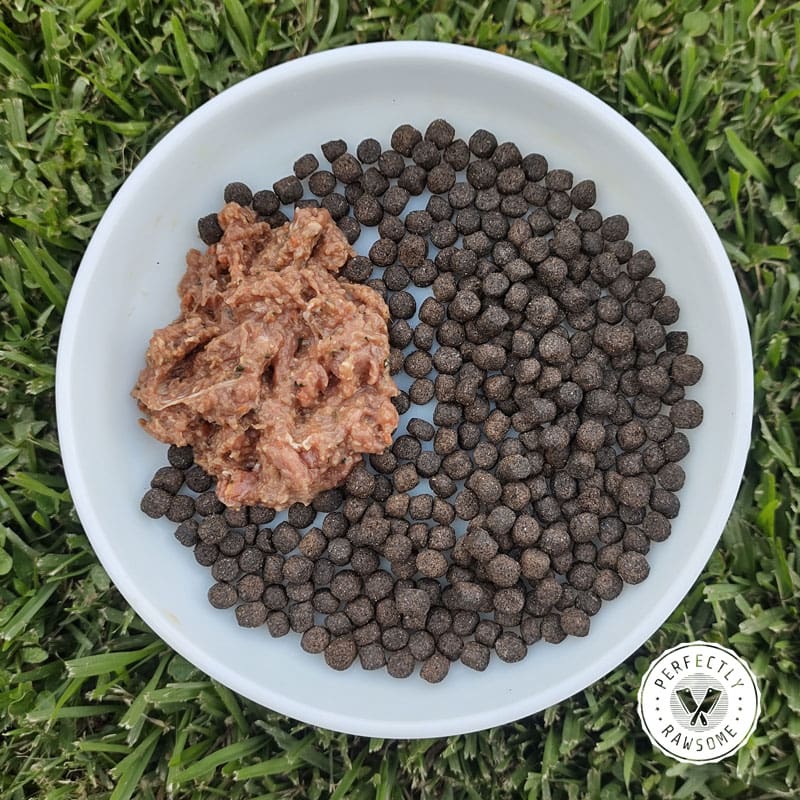
75/25 Puppy Meal Example
For this example, ½ cup of dry dog food would be removed and Darwin’s Natural Selections Beef would be added daily. The daily total should be split into the appropriate amount of meals for the puppy’s age.
8-10 weeks
15 lbs (6.8 kg)
Dry Puppy Food
400 Kcal per Cup
2 cups Fed Daily
800 Kcal Total Daily Calories
Calculate 75% Dry Dog Food:
2 cups x 0.25 = 0.5 cups
Remove 0.5cups of dry dog food.
2 cups - 0.5 cups = 1.5 cups
Feed a total of 1.5 cups of dry dog food a day.
0.5 cups = 200 Kcal
Removing 0.5 cups of dry dog food reduces calories by 200 and needs to be replaced with a balanced premade.
Calculate 25% Raw Premade:
Premade Raw
Darwin’s Natural Selections Beef
Calories per Oz (28.35g)
36 Kcal
200 Kcal Needed
A total of 200kcal of dry dog food was removed from the daily intake.
200 Kcal ÷ 36 Kcal = 5.6oz (159g)
Add 5.6oz (159g) of premade to provide 200kcal of balanced raw.
75/25 Kitten Meal Example
For this example, ¼ can of wet kitten food would be removed and Darwin’s Natural Selections Lamb would be added daily. Kittens should be fed as much as they will eat in a meal sitting. The amount of meals per day should be appropriate for the kitten’s age.
8-10 weeks
2 lbs (1kg)
Canned Kitten Food
200 Kcal per Can
1 can Fed Daily
200 Kcal Total Daily Calories
Calculate 75% Canned Cat Food:
1 can x 0.25 = 0.25 (¼) can
Remove 0.25 can of cat food.
1 can - ¼ can = 0.75 can
Feed a total of 0.75 cans of cat food a day.
0.25 can = 50 Kcal
Removing 0.25 can of cat food reduces calories by 50 and needs to be replaced with a balanced premade
Calculate 25% Raw Premade:
Premade Raw
Darwin’s Natural Selections Lamb
Calories per Oz (28.35g)
49 Kcal
50 Kcal Needed
A total of 50kcal of canned cat food was removed from the daily intake.
50 Kcal ÷ 49 Kcal = 1oz (28g)
Add 1oz (28g) of premade to provide 50kcal of balanced raw.
Once stools have been maintained firm and consistent for 3 days, proceed onto step two of the slow transition.
STEP 2: 50% Processed Food + 50% Balanced Premade
The second step in the slow transition begins to increase the amount of balanced raw food to allow for the further decrease of processed food. Remove another 25% (¼) of the processed food and replace it with another 25% balanced raw food. This will result in meals being 50% (half) raw food and 50% (half) processed food.
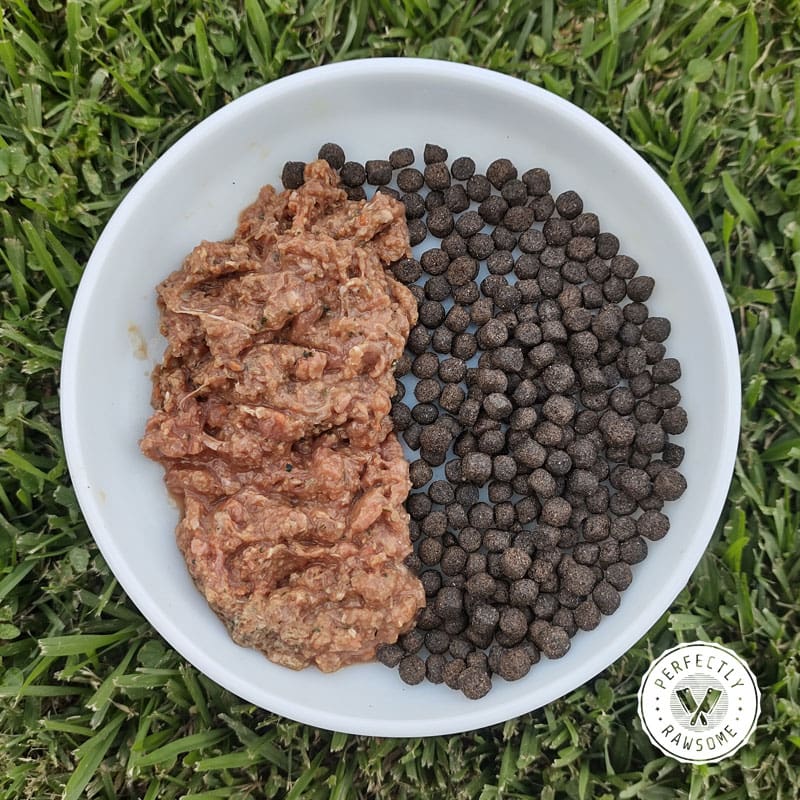
50/50 Puppy Meal Example
For this example, 1 cup of dry dog food would be removed and Darwin’s Natural Selections Beef would be added daily. The daily total should be split into the appropriate amount of meals for the puppy’s age.
Calculate 50% Dry Dog Food:
2 cups x 0.5 = 1 cups
Remove 1 cup of dry dog food.
2 cups - 1 cup = 1 cup
Feed a total of 1 cup of dry dog food a day.
1 cups = 400 Kcal
Removing 1 cups of dry dog food reduces calories by 400 and needs to be replaced with a balanced premade.
Calculate 50% Raw Premade:
Premade Raw
Darwin’s Natural Selections Beef
Calories per Oz (28.35g)
36 Kcal
400 Kcal Needed
A total of 400kcal of dry dog food was removed from the daily intake.
400 Kcal ÷ 36 Kcal = 11oz (315g)
Add 11oz (315g) of premade to provide 400kcal of balanced raw.
50/50 Kitten Meal Example
For this example, ½ can of wet kitten food would be removed and Darwin’s Natural Selections Lamb would be added daily. Kittens should be fed as much as they will eat in a meal sitting. The amount of meals per day should be appropriate for the kitten’s age.
Calculate 50% Canned Cat Food:
1 can x 0.5 = 0.5 can (1/2 can)
Remove 0.5 can of cat food.
1 can - 0.5 can = 0.5 can
Feed a total of 0.5 cans of cat food a day.
0.5 can = 100 Kcal
Removing 0.5 can of cat food reduces calories by 100 and needs to be replaced with a balanced premade
Calculate 50% Raw Premade:
Premade Raw
Darwin’s Natural Selections Lamb
Calories per Oz (28.35g)
49 Kcal
100 Kcal Needed
A total of 100kcal of canned cat food was removed from the daily intake.
100 Kcal ÷ 49 Kcal = 2oz (58g)
Add 2oz (58g) of premade to provide 100kcal of balanced raw.
Once stools have been maintained firm and consistent for 3 days, proceed onto step three of the slow transition.
STEP 3: 25% Processed Food + 75% Balanced Premade
The third step in the slow transition begins to phase out processed food while increasing balanced raw food. Remove an additional 25% (¼) of the processed food and replace it with 25% raw food. This will result in meals being 75% raw food and 25% processed food.
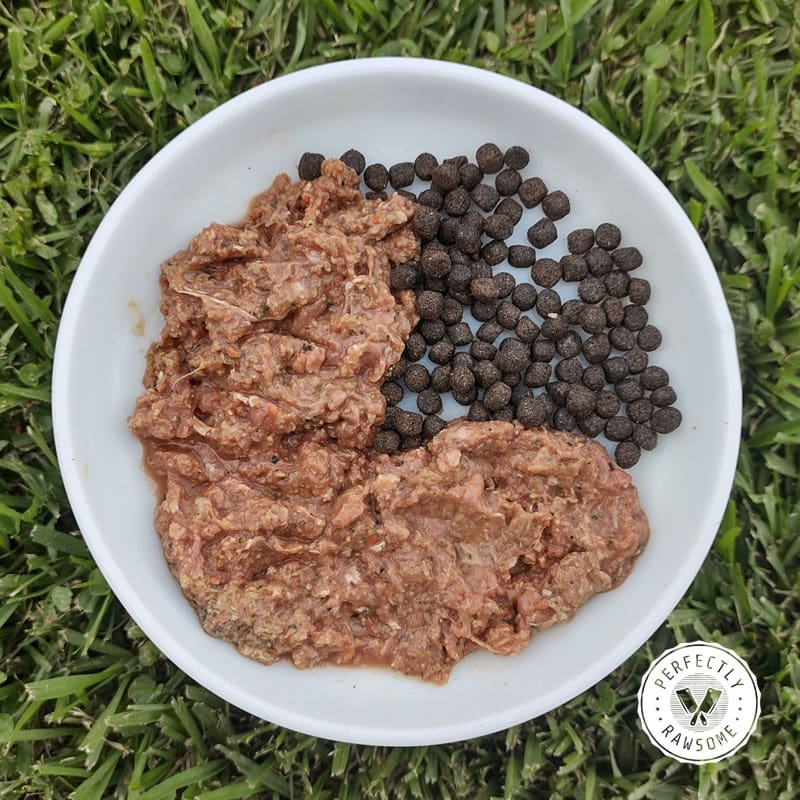
25/75 Puppy Meal Example
For this example, 1.5 cups of dry dog food would be removed and Darwin’s Natural Selections Beef would be added daily. The daily total should be split into the appropriate amount of meals for the puppy’s age.
Calculate 25% Dry Dog Food:
2 cups x 0.75 = 1.5 cups
Remove 1.5 cups of dry dog food.
2 cups - 1.5 cups = 0.5 cup
Feed a total of 0.5 cup of dry dog food a day.
1.5 cups = 600 Kcal
Removing 1.5 cups of dry dog food reduces calories by 600 and needs to be replaced with a balanced premade.
Calculate 75% Raw Premade:
Premade Raw
Darwin’s Natural Selections Beef
Calories per Oz (28.35g)
36 Kcal
600 Kcal Needed
A total of 600kcal of dry dog food was removed from the daily intake.
600 Kcal ÷ 36 Kcal = 17oz (473g)
Add 17oz (473g) of premade to provide 600kcal of balanced raw.
25/75 Kitten Meal Example
For this example, 0.75 can of wet kitten food would be removed and Darwin’s Natural Selections Lamb would be added daily. Kittens should be fed as much as they will eat in a meal sitting. The amount of meals per day should be appropriate for the kitten’s age.
Calculate 25% Canned Cat Food:
1 can x 0.25 = 0.75 can (3/4 can)
Remove 0.75 can of cat food.
1 can - 0.75 can = 0.25 can
Feed a total of 0.25 cans of cat food a day.
0.75 can = 150 Kcal
Removing 0.75 can of cat food reduces calories by 150 and needs to be replaced with a balanced premade
Calculate 75% Raw Premade:
Premade Raw
Darwin’s Natural Selections Lamb
Calories per Oz (28.35g)
49 Kcal
150 Kcal Needed
A total of 150kcal of canned cat food was removed from the daily intake.
150 Kcal ÷ 49 Kcal = 3oz (87g)
Add 3oz (87g) of premade to provide 150kcal of balanced raw.
Once stools have been maintained firm and consistent for 3 days, proceed onto step four of the slow transition.
STEP 4: 100% Raw Food
The final step in the slow transition is to phase out the processed pet food completely. This is the final step of the slow transition to raw food for puppies and kittens.
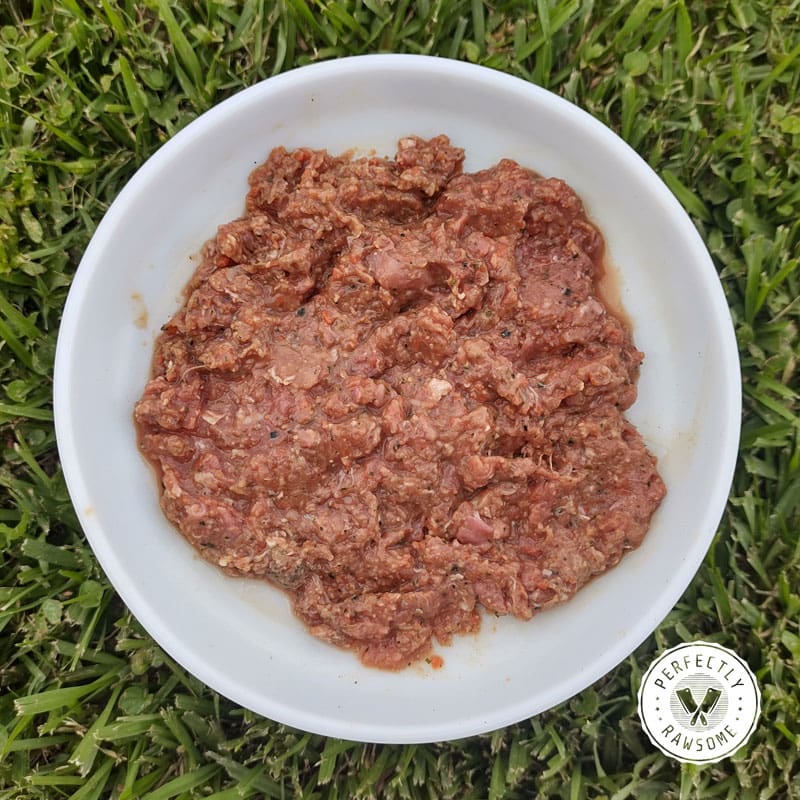
Puppy Meal Example
At this point, all dry food would be removed and Darwin’s Natural Selections Beef would be fed daily. The daily total should be split into the appropriate amount of meals for the puppy’s age.
Calculate 100% Raw Premade:
Premade Raw
Darwin’s Natural Selections Beef
Calories per Oz (28.35g)
36 Kcal
800 Kcal Daily Calories
800 Kcal ÷ 36 Kcal = 22.2oz (624g)
Add 22.2oz (624g) of premade to provide 600kcal of balanced raw.
Kitten Meal Example
At this point, all canned food would be removed and Darwin’s Natural Selections Lamb would be fed daily. Kittens should be fed as much as they will eat in a meal sitting. The amount of meals per day should be appropriate for the kitten’s age.
Calculate 100% Raw Premade:
Premade Raw
Darwin’s Natural Selections Lamb
Calories per Oz (28.35g)
49 Kcal
200 Kcal Daily Calories
200 Kcal ÷ 49 Kcal = 4oz (116g)
Add 4oz (116g) of premade to provide 150kcal of balanced raw.
It is recommended to feed the same food used during the slow transition for a minimum of seven days once the pet has completed the slow transition. This is to allow the puppy or kitten to acclimate to the new diet before introducing any other new foods.
CLOSING COMMENTS
Using a commercially balanced premade food, at least temporarily, can be beneficial to the pet parent rather than creating a homemade puppy recipe. There is a learning curve with raw feeding and this is especially true when feeding puppies and kittens. If a homemade DIY raw diet is the final goal, then a commercial premade raw food is ideal to help the pet parent adjust while learning a new way of providing a nutritionally balanced diet to their pet.
The slow transition steps are designed to introduce sensitive puppies and kittens to a balanced raw diet. Transitioning to raw is exciting but it is best to allow the pet to set the pace if they have a history of gastrointestinal complications with sudden diet changes. The steps provided should be modified as necessary.
Introduce Fresh Food
It is recommended to avoid major diet changes when a new puppy or kitten arrives. Introducing fresh food into their current diet can be accomplished at 20% of the diet.
Balanced Raw Food Options
While it is possible to prepare balanced ground raw food at home for puppies and kittens, it is encouraged to use a commercial premade raw pet food that is balanced for All Life Stages for the slow transition process.
Calculate Calorie Requirements
It will be necessary to calculate the pet’s daily calorie requirements before beginning the slow transition.
Slow Transition Steps
There are four steps to slowly transition puppies and kittens onto raw food to avoid gastrointestinal upset caused by sudden diet change.
Variety is the spice of life and it is encouraged to feed multiple balanced pet foods and proteins whenever possible. Once stools have been maintained firm and consistent for 7 days after the transition is complete, new foods can be introduced if desired. New foods can be introduced using the same transition steps outlined in this article.
